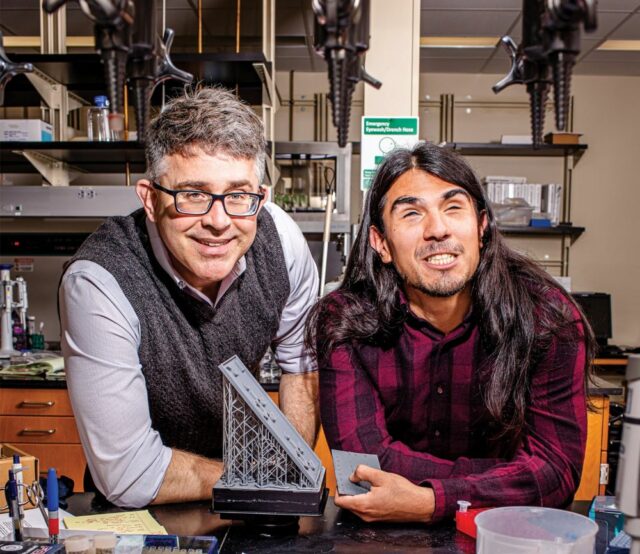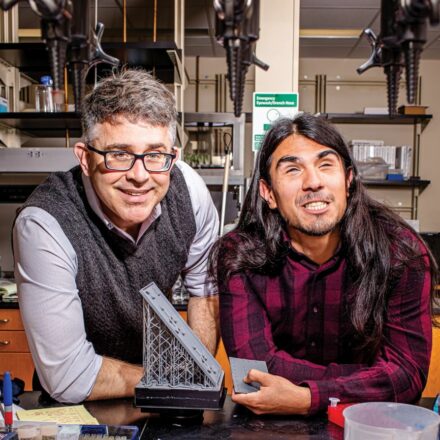By Payal Dhar
“Nobody can see atoms,” says Hoby Wedler, a chemist, educator, entrepreneur and advocate for students in STEM who are blind or have low vision. This makes him wonder: Shouldn’t studying chemistry then be possible for everyone?
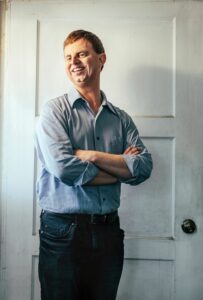
Wedler, who has been blind since birth, earned his Ph.D. in organic chemistry in 2016. “During my graduate career, I did a lot of work to make chemistry more accessible to me,” he says. This included drawing figures with a pen, then flipping the paper over and tracing it to form a thick raised line. “And while this still works really well [for] easy diagrams, they are not permanent.”
Student researchers in STEM who are blind or have low vision are used to finding workarounds for everyday tasks that their sighted contemporaries take for granted—that’s not the problem. The problem is a lack of accessible resources.
Finding solutions in everyday tech
“Being a blind chemist is not always easy,” says Mona Minkara, Ph.D., a researcher in the bioengineering department of Northeastern University in Boston. A lot of the software she needs in her computational lab wasn’t designed with accessible features. Plus, “many people have doubted my abilities throughout my education.”
Minkara says that everyday technologies, such as smartphones, are extraordinarily helpful in supporting people who are blind or have low vision. For example, using integrated assistive features on smartphones speeds up tasks that would be much more time-consuming for her as a researcher who is blind, compared to a sighted one.
At present, accessible materials are fairly sparse, Wedler says. Some of the techniques he has used are tactile graphics such as those provided by machines like Swell Form and Pictures in a Flash. He also used 3D printing as a graduate student. Then, there are molecular modeling kits that can be used by both sighted students and students who are blind or have low vision. Minkara herself has used modeling clay or hot glue guns to make tactile graphics.
“There isn’t much out there, though, for blind students to be able to draw their [own] results and then present them back to their instructor,” Wedler says. One of the hardest things for people who are blind or have low vision in general, especially in fields that rely on a lot of diagrams, is being able to read the literature, he adds. “And because authors all publish their figures differently, and they’re in different formats, it’s very hard to glean enough information from the caption of the figure to really understand what’s happening.” For this, scientists often have to make use of assistants and readers, that is, people who can help scientists and students read journal articles.
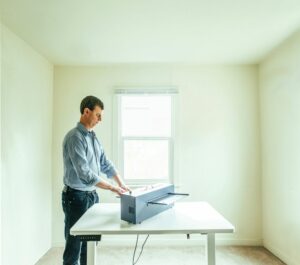
Daniel Hajas, Ph.D., who went blind at 16, reports much the same experience in his pursuit of degrees in physics and informatics. Commercial screen readers weren’t able to read equations, for which he had to use other, open source applications. “But when it came to diagrams and graphs, I had to rely quite a lot on human assistance, somebody actually sitting with me, talking me through [them].” His university did purchase a tactile embosser eventually, but, with a lack of training, it took students a long time to figure out how best to use it.
Different ways of seeing
In search of better solutions, Wedler, along with other collaborators who are blind or have low vision and sighted collaborators, recently co-authored a study that looks at 3D-printed lithophanes as a means of creating diagrams and other figures that can be universally visualized, irrespective of the level of vision.

Lithophane comes from the Greek lithos (stone) and phainen (appearing) but has nothing to do with stones—or Greece, for that matter. Some scholars credit the idea of creating art using translucent porcelain to the Chinese Tang Dynasty; however, modern lithophanes originated in Europe in the early 1800s. These were thin, delicate engravings in porcelain or wax that appeared opaque at first glance but lit up in depth and detail when held against a light source.
Led by Bryan Shaw, Ph.D., a professor of chemistry and biochemistry at Baylor University, researchers analyzed whether sighted participants and those who are blind or have low vision were able to interpret the same lithophane data by sight and touch, respectively. Both Wedler and Minkara were collaborators in the study.
In recent years, 3D printing has given a new lease on life to lithophanes. Shaw and colleagues used it to create five different lithophanes of gel electropherograms, micrographs, electronic and mass spectra, and textbook illustrations.
They are inexpensive to produce, less than $10 for a full-page visual, says Wedler, and easy to create. “Basically, we design an image, and then we use software to create the lithophane, which then gets transferred immediately to the 3D printer.”

The researchers found that participants were able to interpret the images by touch or sight at almost 80% overall accuracy. Lithophanes can be very useful in any classroom setting that needs visual diagrams, Wedler points out. Unlike existing tactile graphics, Braille diagrams or tactile models, which tend to be lower resolution, lithophanes can be incredibly detailed, with video-like resolution. “The amazing thing about it is that if you’re studying in a group, a blind student can feel the lithophane, and a sighted student can hold the same lithophane up to a light and see exactly what the blind student is feeling,” Wedler says.
Accessible by design
Hajas works at the Global Disability Innovation Hub in London, where, as innovation manager, he supports assistive technology entrepreneurs. He also collaborates with computer scientist and visual artist Jonathan Zong and his team at the Massachusetts Institute of Technology to develop accessible data visualization tools using natural language descriptions.
“Our approach [brings] multidisciplinary academic expertise together with Daniel’s expertise and experiences as a blind researcher,” Zong says. “Centering the experiences of blind users in the design process helped us set accessibility as a baseline expectation, [such as prioritizing] the agency of blind users to do self-guided data exploration at various levels of detail and facilitate collaboration with sighted users.”
For accessibility to be mainstream, it needs to be more than an add-on: It must be baked into the system. This is what Julia Winter, a former high school chemistry teacher, learned when she founded Alchemie to develop interactive learning tools for young STEM learners.
The whole idea of success in education is driven by a sense of belonging. If you develop a tool that a sighted kid can use side by side with a blind kid, then, all of a sudden, it makes for a better experience for both of them.
—Julia Winter, founder and CEO, Alchemie
She found a problem: Interactive, experiential learning tools are not necessarily accessible and can’t reach the market in the U.S. because the Americans with Disabilities Act requires learning tools to be accessible. “We decided that we would look at accessibility first and develop our technology for the general audience,” Winter says.

So Alchemie came up with Kasi, a multisensory augmented reality system that uses physical manipulatives and computer vision, Winter explains. “And the pedagogy to help kids who are blind have their own experience that allows for independent learning.”
Learning support for students who are blind or have low vision right now is primarily provided through remediation or preparation, in which they don’t get to participate in science lessons in the same way as their sighted counterparts. “The whole idea of success in education is driven by a sense of belonging,” Winter says. “If you develop a tool that a sighted kid can use side by side with a blind kid, then, all of a sudden, it makes for a better experience for both of them.” Alchemie, therefore, works with an “accessibility first” approach, with a focus on abilities and inclusion.
For both Winter and Zong, who are sighted, working with collaborators who are blind or have low vision is essential. “I bring extensive knowledge of data visualization systems and interaction design,” says Zong, “but rely on collaborators that understand the lived experience of primarily using screen readers every day. These collaborations create opportunities to discover new approaches that are greater than the sum of their parts.”
He adds that designing for accessibility from the beginning pushes designers to consider sensory representations as cognitive tools that don’t have to be vision-centric: “They can account for the diverse ways that people use their senses.”
Disability is a social issue
Reframing a disability—whether blindness or any other—as something that is created by society, by social or attitudinal barriers, puts the onus on society to make spaces accessible by default.
“I ask my sighted colleagues to consider the accessibility of written materials, to elevate the inclusivity of lab environments holistically,” Minkara says. “For example, if I am attending a group meeting with a presentation, it is extremely helpful [to have] the slide deck in advance, including alt text to describe the pictures and graphs [so] I will have context to anticipate group discussions around any data that would otherwise be inaccessible to me.” Word documents are also more accessible than PDFs, as screen-reading software often interprets text in the latter as an image, which hinders reading.
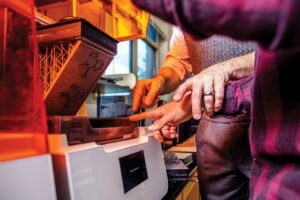
Hajas would like to see more commitment to implementing policies and best practices related to inclusion: “Lots of institutions have excellent policies and guidelines and everything beautifully set out, but it doesn’t really translate into action.” It is usually because the people who know what to do are not those who are on the stage; this is the gap that needs bridging.
The media, says Wedler, could help by focusing on success stories: “Just writing about people who have figured out how to do things, and explaining how they have done them, provides good resources for anyone to be able to apply it at their own institution or for themselves.” That is more helpful than, “Wow, look at this amazing blind chemist,” he adds.
Another important role of the media is to dispel misconceptions, Hajas says. For example, the idea that most students who are blind use Braille, when, in practice, only a small percentage are even taught how to read Braille. The other is thinking that users who are blind need special computers: “I’m using an Apple and a Dell computer just like anybody else, with the right assistive technology on it,” says Hajas.
“Blind people can do whatever they want, given the right technology and the correct support,” Wedler says. “So, if we just work with students to figure out how we can best support them, they will be able to succeed the same way sighted students will. But we need to work with them as a team rather than thinking about accessibility as a challenge or a problem. Anything is possible with the right mindset.”
Lead photo: Cook (R) uses 3D-printed lithophanes to learn about metalloproteins alongside Professor Shaw. Photo by Drew Anthony Smith.
Want to read more stories like this? Check out Realize magazine.
